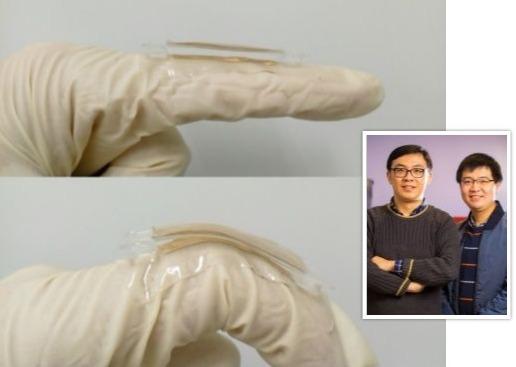Researchers Turn to the Human Body for Power

That sentiment compelled a team of Chinese and U.S. researchers to look for a solution, which led to the development of a small metallic tab that uses the human body to generate electricity.
In a study published in the industry journal Nano Energy, researchers at the University at Buffalo and the Institute of Semiconductors (IoP) at the Chinese Academy of Sciences (CAS), explained that the tab, which attaches to the body, generates electricity from simple movements such as bending a finger.
“The human body is an abundant source of energy,” said lead author Qiaoqiang Gan (left in photo). “We thought: Why not harness it to produce our own power?”
The prototype tab — known as the triboelectric nanogenerator — is 1.5 centimeters long by 1 centimeter wide (about 0.6 x 0.4 inches) and was able to deliver maximum voltage of 124 volts, maximum current of 10 microamps, and maximum power density of 0.22 milliwatts per square centimeter. Though not enough to quickly charge a smartphone, it was enough juice to simultaneously light up 48 red LED lights.
Triboelectric charging occurs when certain materials become electrically charged after coming into contact with a different material. Static electricity is a familiar example of this phenomenon. The tab comprises two thin layers of gold, with polydimethylsiloxane (PDMS), a silicon-based polymer used in contact lenses, Silly Putty, and other products, sandwiched in between.
How’s it work?
One layer of gold is stretched, causing it to crumple upon release and create what looks like a miniature mountain range, the researchers explained. When that force is reapplied — from a bending finger, for example — the motion leads to friction between the gold layers and PDMS.
"This causes electrons to flow back and forth between the gold layers,” explained Yun Xu, professor of IoP at CAS. “The more friction, the greater the amount of power produced."
The team is planning to conduct tests using larger pieces of gold, which when stretched and folded together, are expected to deliver more electricity.
Researchers say the next step down this research path is to develop a portable battery to store energy produced by the tab. The researchers envision the system serving as a power source for various wearable and self-powered electronic devices, and note that they are taking into consideration practical concerns such as difficulty of manufacture and cost-effectiveness.



















































